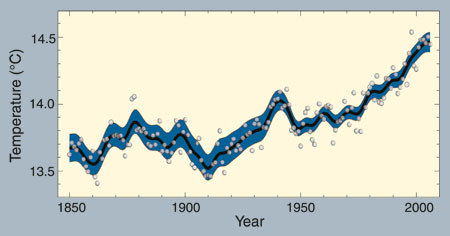 |
|
|
|
|
|
|
The mean global surface temperature has increased considerably since around 1900 (Fig. 1) and will probably further increase. However, temperature changes vary significantly among different areas, being largest above the land surface, especially at high northern latitudes. This means that temperature increase will be higher in higher northern latitude mountains than in mountains located in temperate and tropical zones. Also, temperature changes vary according to the seasons: A stronger increase in temperatures has been measured in winter and spring than in summer, and minimum temperatures have increased more than maximum temperatures. |

1 - Global average surface temperature (IPCC 2007) |
|
The most immediate and visible effects of temperature increase can be observed in the cryosphere, i.e. in snow, ice and glaciers. As temperature is a limiting factor in alpine environments, climate warming is expected to have considerable effects on alpine ecosystems. Besides direct effects on photosynthesis and growth of alpine plants, higher temperature is accelerating decomposition and mineralization, leading to higher nutrient availability in these usually nutrient poor environments. As changes in temperature affect a wide range of ecosystem processes at different rates, severity and direction of warming effects presumably will change over time. Another important factor in non-tropical alpine ecosystems is the duration of the vegetation period, which already has expanded by up to two weeks in mid- and high northern latitudes. For alpine lakes, the duration of ice cover is an important factor. Warming will lead to a prolonged ice-free season, higher water temperature and stronger thermal stratification. Higher temperature and an increase in nutrient input from the catchment will increase the productivity and result in community changes and the invasion of species adapted to warmer and more productive waters. |
13 August 2018 |
||
| |
||